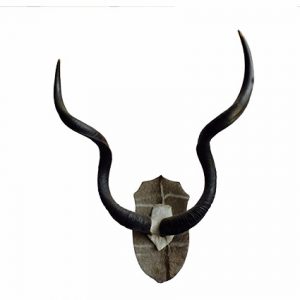Description
Kudu Taxidermy Mounts For Sale.
Pan African Art Gallery, Kudu shoulder mount for sale in South Africa. We mount quality Kudu taxidermy mounts that looks good and should last a life time. The more are taken care of, the more you will find joy in looking at for years to come.
Like many other antelope, male kudus can be found in bachelor groups, but they are more likely to be solitary. Their dominance displays tend not to last long and are generally fairly peaceful, consisting of one male making himself look big by making his hair stand on end. When males do have a face-off, they will lock their horns in a competition to determine the stronger puller; kudus’ necks enlarge during the mating season for this reason. Sometimes two competing males are unable to unlock their horns and, if unable to disengage, will die of starvation or dehydration. Males are seen with females only in the mating season, when they join in groups of 5–15 kudus, including offspring. Calves grow very quickly and at six months are fairly independent of their mothers.
A pregnant female will leave the herd to give birth to a single offspring. She will leave the newborn lying hidden for 4–5 weeks while coming back only to nurse it, which is the longest amount of time for any antelope species. Then the calf will start meeting its mother for short periods. At 3 or 4 months, the calf will be with its mother constantly, and at about six months they will permanently join the group.
When threatened, the kudu will often run away rather than fight. Wounded bulls have been known to charge the attacker, hitting the attacker with their sturdy horn base rather than stabbing it. Wounded females can keep running for many miles without stopping to rest for more than a minute. They are great kickers and are capable of breaking a wild dog‘s or jackal‘s neck or back. They are good jumpers and can clear a 5-foot fence from a standing start.
Kudus are browsers and eat leaves and shoots. In dry seasons they eat wild watermelons and other fruit for their liquid content and the natural sugars that they provide. The lesser kudu is less dependent on water sources than the greater kudu.
Kudu meat is similar to venison (deer), with a slight gamey, liver-like flavor. It is a very dry and lean meat, so it needs to be cooked carefully to avoid drying it out and making it difficult to eat. When prepared correctly, it can be very healthy because of its low fat content.
Dimensions:
- Tip of the horn to shoulder: 150 cm
- Back to mount: 90 cm







Reviews
There are no reviews yet.